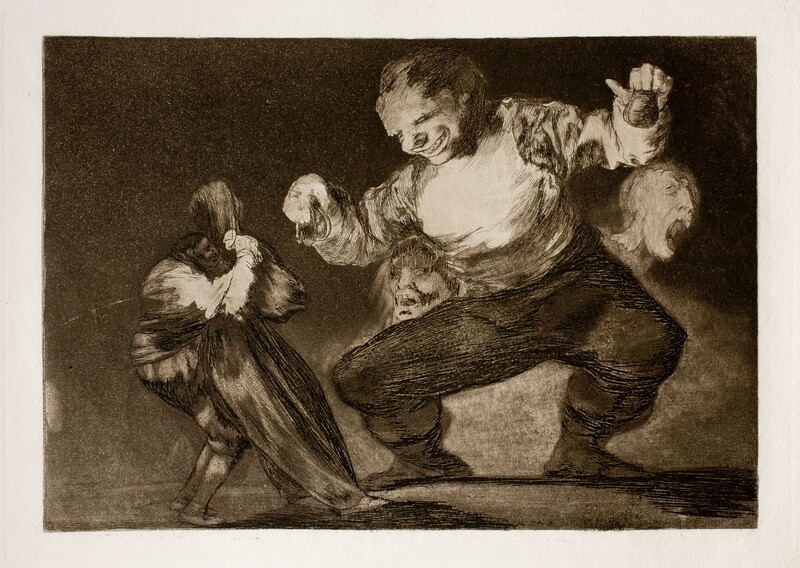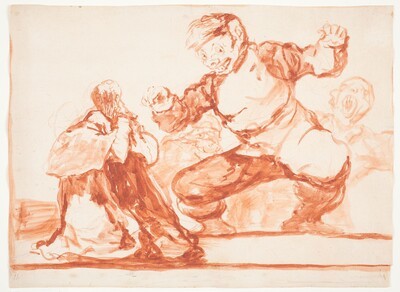- Cronología
- 1815 - 1819
- Dimensiones
- 247 x 359 mm
- Técnica y soporte
- Aguafuerte, aguatinta bruñida, punta seca y buril
- Reconocimiento de la autoría de Goya
- Documented work
- Ficha: realización/revisión
- 21 Aug 2021 / 05 Jun 2023
- Inventario
- -
Goya (print, bottom left-hand corner)
See Femenine folly
There are state proofs before the aquatint in the Library of the University of Paris, in the Kunsthalle in Bremen and in the New York Public Library. In the latter proof, another character appears next to the man.
In the Pereire Collection there is a state proof on which the legend "Bobalicon" can be read.
A large monster dances and plays castanets before a terrified man who hides behind a stiff, almost spectral being hidden under a shroud. The giant, of indeterminate sex, wears men's trousers and an unbuttoned blouse revealing a female-looking torso. Behind him, two ghostly heads appear, one with its mouth open in terror, the other as if petrified by terror.
The meaning of this print is enigmatic, as the name was not given by Goya but comes from a posthumous annotation on a copy from the mid-19th century, so perhaps the Aragonese artist's intention was different.
The man depicted is usually associated with a member of the clergy, as in the preparatory drawing, also entitled Simpleton's folly, he wears a kind of habit, and the rigidity of the figure he is holding is reminiscent of a statue or religious image. In the engraving he does not look so much like an ecclesiastic as an ecclesiastic, but he is wearing a kind of cloak over his head. One of the explanations that have been attempted for this print is related to religion and the Church, and even to the aristocracy, as in some proofs an additional figure appears. The castanets are a typically Spanish instrument, so that by wearing them, the giant could symbolise the uprising of the Spanish people against these oppressive classes. Hence the fear of the character hiding behind religion.
A relationship has also been seem with the tradition of Carnival, with the character of the fool, who when he was very old was called Bobalicon. In this case we would be faced with the confrontation of two practices, Lent and Carnival.
A dark aquatint was applied to the light etching to create an abstract space in which the ground is barely distinguishable from the horizon line. Thanks to the burnisher, Goya achieved half-tones.He used drypoint on the heads at the back and touches of burin on the one on the right. The lighting is centred on the giantess to show her large wingspan.
The preparatory drawing for the present print, also entitled Simpleton's folly, has been preserved.
-
Etchings by Francosco GoyaJohannesburgoJohannesburgo1974
-
1976
-
Grabados de Goya: colección propiedad de la Biblioteca Nacional, que se conserva en su Gabinete deCasa de la Amistad de MoscúMoscow1979exhibition displayed from January 18th to 31st 1979
-
Goya. Das Zeitalter der Revolucionen. Kunst um 1800 (1980 – 1981)Hamburger KunsthalleHamburg1980cat. 54
-
Goya y el espíritu de la IlustraciónMuseo Nacional del PradoMadrid1988from October 6th to December 18th 1988. Exhibited also at Museum of Fine Arts, Boston, January 18th to March 26th 1989; The Metropolitan Museum of Art, Nueva York, May 9th to July 16th 1989, Madrid curator Manuela B. Mena Marqués, scientific directors Alfonso E. Pérez Sánchez and Eleanor A. Sayre
-
Francisco Goya. Sein leben im spiegel der graphik. Fuendetodos 1746-1828 Bordeaux. 1746-1996Galerie KornfeldBern1996from November 21st 1996 to January 1997
-
Goya. 250 AniversarioMuseo Nacional del PradoMadrid1996consultant editor Juan J. Luna. From March 29th to June 2nd 1996
-
Goya grabadorMuseo del Grabado Español ContemporáneoMarbella1996from March 8th to May 5th 1996
-
Zaragoza1996
-
London1997
-
1999
-
Madrid1999
-
Schlaf der Vernunft. Original radierungen von Francisco de GoyaMunich2000
-
Bilbao2012
-
Goya et la modernitéPinacothèque de ParisParís2013from October 11st 2013 to March 16th 2014cat. 204
-
Goya: Order and disorderMuseum of Fine ArtsBoston2014cat. 237
-
Agen2019cat. 68
-
2022
-
OxfordBruno Cassirer1964pp. 378-379, cat. 251
-
Vie et ouvre de Francisco de GoyaParísOffice du livre1970p. 325, cat. 1576
-
Catálogo de las estampas de Goya en la Biblioteca NacionalMadridMinisterio de Educación y Cultura, Biblioteca Nacional1996p. 236, cat. 378
-
MadridReal Academia de Bellas Artes de San Fernando y Calcografía Nacional1996pp. 105 y 109, cat. 4 y 24
-
MadridMuseo Nacional y Ediciones El Viso2008pp. 476-477, cat. 176
-
MadridConsejo Superior de Investigaciones Científicas2010p. 478
-
ParísPinacoteca de París2013p. 271
-
Goya: Order & DisorderBostonMuseum of Fine Arts Boston Publications2014pp. 337-340
-
Goya. In the Norton Simon MuseumPasadenaNorton Simon Museum2016pp. 204-211
-
AgenSnoeck2019p. 146
-
Museo de Bellas Artes de Badajoz y Diputación de Badajoz2022p. 93

